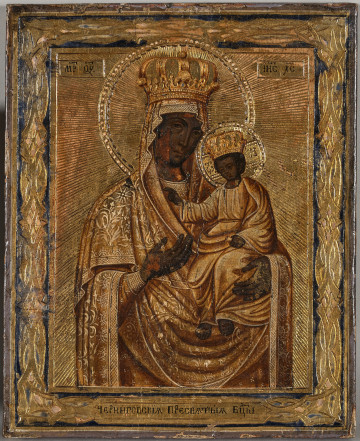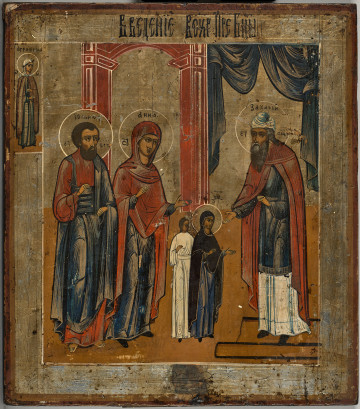
The Mother of God of Hodigitria
19th (?) century
Castle Museum in Łańcut
Part of the collection: Ikony
Crucifixion, silhouette icon. Objects of worship cast from metal alloys were initially brought to Rus from Byzantium. Locally crafted objects modelled after their Byzantine predecessors appeared in the 11th c. and became widespread in 12th-13th c. Important centres of their production were Kiev, Veliky Novgorod, Moscow, and then others. Crucifixes were particularly desirable. In the Rus tradition, the eight-pointed cross with three crossbeams became popular (see S.12789MŁ; S.12792MŁ; S.12793MŁ; S.12795MŁ; S.12869MŁ; S.12871-12876MŁ). It was deemed the only acceptable one by the followers of the old Church tradition, known as Old Ritualists. They did not accept the liturgical reform started by Moscow's Patriarch Nikon in the middle of the 17th c. The persecuted Old Ritualists developed and dominated the production of metal objects of worship since the end of the 17th c. Their products were readily used or imitated and copied by the followers of the official Orthodox Church. Individual communities of Old Believers developed and applied their own rules of depiction. The details of some portrayals and inscriptions, accepted by some, were deemed heretical by other communities. A fundamental difference in the views on portraying and describing depictions emerged between the communities of the Priestless Old Believers, who renounced priests after the reform, and the Priested Old Believers, who used the services of priests. From the middle of the 18th c. in central Russia, in the Guslitsa region near Moscow, a new community of Priested Old Believers developed. In the 19th c., Guslitsa became one of the most important centres of metal casting, producing crosses, individual and folding icons, etc. A characteristic feature of the products from Guslitsa and those modelled on them were the winged heads of cherubs mounted on pins (see S.12795MŁ; S.12872MŁ; S.12875-12876MŁ). In larger quantities, the cherubs sometimes formed an openwork wreath on the closing of the crucifix or icon. Teresa Bagińska-Żurawska https://orcid.org/0000-0002-9243-3967
Dimensions
height: 11.2 cm, width: 6.4 cm
Object type
Icons
Technique
cast
Material
bronze
Origin / acquisition method
decyzja administracyjna
Creation time / dating
Creation / finding place
Owner
Castle Museum in Łańcut
Identification number
Location / status

19th (?) century
Castle Museum in Łańcut

1800 — 1850
Castle Museum in Łańcut

1800 — 1899
Castle Museum in Łańcut
DISCOVER this TOPIC
Museum of King Jan III's Palace at Wilanów
DISCOVER this PATH
Educational path